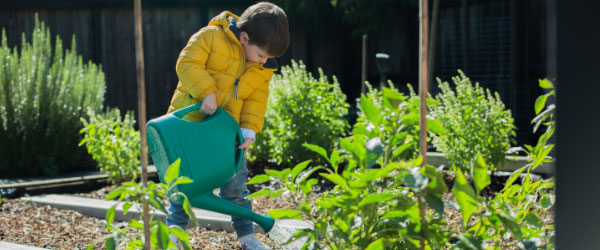Have you ever put your discarded green onion ends into a cup of water?
The roots grow, the green stalk returns, and soon enough the plant will shoot up and you’ll have a whole new green onion to use again— for free.
This is just one way to give compost scraps a second life— a joyful pastime many people discovered during the pandemic.
If you haven’t given this little ‘indoor veggie gardening hack’ a try, now’s the time, especially if you have children around.
Caring for a plant, even something as small as a green onion in a cup, is a great skill to nurture in children, and it’s just one of the many positive benefits of gardening.
Winter gardening for kids – getting started
1. Grow a winter veggie garden outside
With Australia’s relatively mild winters, outdoor gardening is still an option for many families. Hardy vegetables, like beets, kale, cabbage, broccoli, potatoes and squash, do best in colder climates.
Start your seeds indoors in plastic containers with drainage holes. You can use yogurt or plastic egg containers with plastic wrap on top to create a greenhouse effect. Place them in a warm location and keep the soil moist.
Give your kids the responsibility of watering and checking on them, building excitement for when the seedlings sprout in about two to three weeks.
Once the seedlings sprout, move them into a cooler, brighter location by a window or under supplemental fluorescent lights. You can also use a fertilizer to provide nutrients.
The hard part is thinning the seedlings. Choose the healthiest, strongest-looking seedling of the bunch and discard the rest. This is a necessary step as you want to make sure the healthiest plant gets all the nutrients it needs to survive.
Once the plants have two leaves, they’re ready to be acclimatised to the cold. This is when you have to baby your plants, bringing them outside for short periods of exposure during the day, gradually increasing the total number of hours they spend outside.
After about seven to 10 days, if the plants still look healthy, they’re ready to be moved into the outdoor garden.
It may sound like a lot of work— but put the kids in charge and watch how they flourish when given a set task, responsibility and ownership over a living thing.
2. Plant a windowsill herb garden
If you want something a little less work intensive, start with an indoor windowsill herb garden. You can start it from seed or buy seedlings at the store. Get your child involved in choosing the herbs for the garden.
A simple windowsill garden can be a good way of testing out whether your kids are interested in this hobby before investing more time and energy into it.
Just make sure to keep them engaged in the process— put them in charge of watering and harvesting the herbs for dinner. Who knows? Maybe you’ll have a little chef in the making.
3. Work on some garden crafts
If venturing out into the cold doesn’t sound like your idea of fun, envision your summer garden and ways to brighten up the days ahead.
Get your kids to paint rocks, flower pots or bird feeders— inexpensive items that can be placed around your garden for decoration or be given as gifts to friends and family.
Get some gardening books out of the library, visit botanical gardens, and plan out what you want to grow in the summer.
Get your kids involved in the decision-making and encourage them to dream up their own small garden plot, sparking curiosity and creativity.
Gardening has so many benefits for both adults and children, and it’s so easy to get started.
Buy some seeds, get your hands dirty, and relish in the sense of achievement and reward when your plants start to grow.

